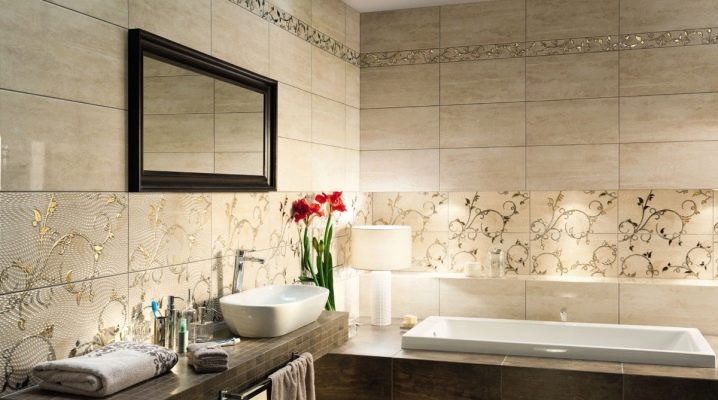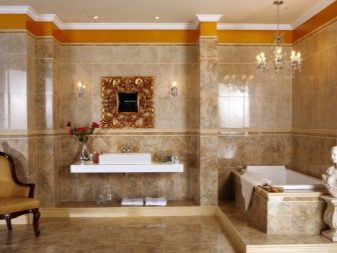Tiles in different styles for the bathroom

With all the variety of modern finishing materials, tiles remain the traditional solution for decorating bathrooms. But in each style, it should be slightly different than in other interiors. You need to understand all the intricacies in advance, even before buying.

Peculiarities
The use of ceramic tiles in bathrooms has a number of advantages. In particular, it is extremely resistant to moisture and has a long service life. There are many options for such a coating on the market.
Once laid, it is much easier to care for than other materials. But in order to beautifully lay out the tiles in the apartment, you need to take into account all the features and nuances.




Most popular versions
Let's take a look at the most popular bathroom tile styles.
- Provence appeared on the shores of the Mediterranean Sea, and created it by the inhabitants of the eponymous territory of France. Lightness, grace and elegance are embodied in this style at the same time. Tiles of the corresponding type are always painted in muted (and even a little dusty) shades of color. Wall and floor surfaces serve only as a backdrop for the powerful and varied decor that Provencal interiors abound with. In addition to pastel colors, woody colors (in various forms) show themselves well.



- Modern style in relation to ceramic tiles, it cannot be considered as something single and monolithic. Until recently, the dominant minimalism disappeared from the scene, and it is no longer necessary to follow strict lines. But more and more important features of the latest versions of tiles are its extravagance and pretentiousness. If you manage to create an unexpected form or organize an ensemble that arouses admiration, is perceived as unexpected, then this is exactly what you should do. It is important that the tile is no longer limited to ceramics - in a modern way, it can be glass, metal, cork, and so on.




- The complete opposite of the modernist approach is tile. country... This format originated in the 1920s, but now it is undergoing a real renaissance. A characteristic feature of the style is that along with signs that are inviolable for all its subspecies, each of them has a national specificity. In any case, tones are used as close to nature as possible, and they should be uniform and without bright accents. Such decoration is combined with all other elements of the interior according to the principle of contrast.




The power of tradition and exoticism
Classic ceramic tiles have the undeniable advantage that they are always in fashion. Whatever the various designers and builders decide, whatever the neighbors and work colleagues say, this is the material that fits, if not for centuries, then for many decades.
The main requirement in the selection of material is the quality of imitation of natural coatings (primarily stone).



Retro-style flooring helps to underline the commitment to tradition. Quite a few manufacturers have already mastered the production of just such tiles, and both the decoration of the past centuries and the old-fashioned tile of the middle of the twentieth century can be imitated.
Many retro collections are designed to use ceramics as a backdrop for more expressive design elements.At the same time, a significant part of the models contains images of former celebrities and other classic subjects.


Imitation of coatings that were laid before the beginning of the last century implies the use of plant, ornamental or geometric motifs in the drawing. When the avant-garde spirit is copied, priority is given to a surface that appears to be made of glass or metal. Tiles in antique style embody one general idea - as accurately as possible reproduce the look of natural stone.


Ornaments with a floral or geometric plot are quite acceptable., and, ideally, they should not differ from the style characteristic of historical antiquity. In some cases, you can use tiles with inclusions that imitate gilding. With a sufficient area of the bathroom and the availability of free money, you can even order a whole volumetric panel in the Greek key.


If this solution does not suit you at all, you should take a closer look at the tiles in the Arabian (oriental) style. It perfectly combines with minimalist surroundings and harmoniously complements it.
In most cases, exoticism based on the Arabian East emphasizes the extravagance and originality of the taste of those living in the house. If there are already other non-standard elements, it is better to look for an alternative solution. The rhythmically built ornament reveals its visual advantages against a plain background, painted in calm tones.




In the Egyptian version, ceramic tiles are characterized by:
- patterns formed by yellow and brown tones;
- periodic addition of golden details;
- when using a small ornament around the perimeter - its strict geometry.



A different approach was invented in Morocco and other countries of the Maghreb. The tiles, aged in the appropriate key, combine white, blue and light blue paints. In addition to them, blotches of beige, green and orange tones are introduced. For the bathroom, it is advisable to select material with patterns of cold colors.
If the area of the room is small, then it is better to give preference to tiles with a small pattern.



Completing the review of bathroom finishes in an exotic vein is appropriate for the Japanese style.
It is always characterized by:
- the severity and conciseness of all lines, configuration in general;
- the predominance of saturated dark or saturated light colors (in different collections);
- regardless of the chosen color - the rest of the decor is in the real Japanese style.



The use of hieroglyphs, on the other hand, is not always practiced. The majority of manufacturers prefer to demonstrate a well-developed accent with other expressive means.
Bright colors are categorically unacceptable, even as an accent on secondary styling fragments.

A bold yet eye-catching move - the use of island-style tiles, with images of nature and things traditionally associated with the land of the rising sun. It is not a problem to choose a suitable option: in the assortment of almost every manufacturer there is a version or even a whole collection, which is called “Sakura”. Natural colors will be harmoniously displayed if they are accompanied by a texture of the same spirit.

About other styles
The listed options are not limited to the variety of bathroom tiles. For example, a coating in the English style always has a lot of small details, often heraldic royal lilies become the plot for finishing materials. White tiles with narrow red, green or blue lines also fully comply with the style canons. No wonder: for a country like Great Britain, nautical motives and references to ocean travel are quite natural. And the English style, like the Japanese, has such a feature as duplicating the type of natural wood.



Preferred are those tile sets that even reproduce the texture of wood and create the feeling of real cracks when touched.
The complete opposite of the British standard is found in the loft. The most popular type of finish in this style is imitation of brickwork. The “concrete” surface is only slightly inferior to it in demand. The advantage of such a coating is its neutrality, easy integration into any interior.




The loft can also be built on imitation of wood, and this imitation is absolutely resistant to water. Scandinavian-style tiles will surely attract the attention of those who do not want to decorate their bathroom "for an industrial enterprise".
Walls with such a choice should be white, or at least completely light.
The tile will be monochromatic or non-standard patterns will be used in its design - only the owners of the house decide.



Anyone who wants to modernize their home a little - chooses the patchwork option. There are mainly floral versions of such tiles on the market, but finding specimens where a geometric ornament or abstraction would be used is also not difficult.
To obtain an unusual finish, the tiles are laid without fitting to the pattern.
If the bathroom is decorated in a high-tech style, you should focus on mirror and other modern varieties of finishing tiles. It is even possible to imitate natural stone, but only in a one-color version. When you absolutely do not like the monochromatic version, you can safely combine two or three shades that are close in spirit.



Among the popular styles of ceramic tiles, there is now also Art Nouveau. This approach is quite compatible with floral design. Moreover, those extremes of a technogenic bias, which are characteristic of a loft or constructivism, are completely absent here. When decorating, brown, green, beige and other colors typical of wildlife are actively used.



In the bathroom, blue-gray and pearl-gray complement the list of preferred colors.
With these guidelines in mind, it will be easy and simple to create an attractive interior in any bathroom.



How to choose the right bathroom tiles, see the video below.













The comment was sent successfully.